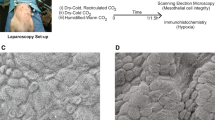Abstract
Background
Carbon dioxide (CO2) is the most common gas used for insufflation in laparoscopy, but its effects on peritoneal physiology are poorly understood. This study looks at the changes in peritoneal and bowel serosal pH during CO2 pneumoperitoneum, and whether heating and humidification with or without bicarbonate alters the outcomes.
Methods
Twenty-one pigs divided into four groups as follows: (1) standard (STD) laparoscopy (n = 5); (2) heated and humidified (HH) laparoscopy (n = 6); (3) heated and humidified with bicarbonate (HHBI) laparoscopy (n = 5); and (4) laparotomy (n = 5). Peritoneal pH, bowel serosal pH, and arterial blood gas (ABG) were obtained at 15-min intervals for 3 h.
Results
Severe peritoneal acidosis (pH range 6.59–6.74) was observed in all laparoscopy groups, and this was unaltered by heating and humidification or the addition of bicarbonate. Bowel serosal acidosis was observed in all laparoscopy groups with onset of pneumoperitoneum, but it recovered after 45 minutes. No significant changes in peritoneal or bowel serosal pH were observed in the laparotomy group.
Conclusion
CO2 pneumoperitoneum resulted in severe peritoneal acidosis that was unaltered by heating and humidification with or without bicarbonate. Alteration in peritoneal pH may conceivably be responsible for providing an environment favorable for tumor-cell implantation during laparoscopy.





Similar content being viewed by others
References
G Bischof E Cosentini G Hamilton et al. (1996) ArticleTitleEffects of extracellular pH on intracellular pH-regulation and growth in a human colon carcinoma cell-line Biochim Biophys Acta 1282 131–139 Occurrence Handle10.1016/0005-2736(96)00050-8 Occurrence Handle1:CAS:528:DyaK28XjtFarsr8%3D Occurrence Handle8679650
RC Buck (1973) ArticleTitleWalker 256 tumor implantation in normal and injured peritoneum studied by electron microscopy, scanning electron microscopy, and autoradiography Cancer Res 33 3181–3188 Occurrence Handle1:STN:280:CSuD2cfnslM%3D Occurrence Handle4760534
EM Clary SM Bruch CL Lau A Ali EG Chekan MJ Garcia-Oria S Eubanks (2002) ArticleTitleEffects of pneumoperitoneum on hemodynamic and systemic immunologic responses to peritonitis in pigs J Surg Res 108 32–38 Occurrence Handle10.1006/jsre.2002.6520 Occurrence Handle1:STN:280:DC%2BD38not12gsg%3D%3D Occurrence Handle12443712
L Diebel J Saxe S Dulchavsky (1992) ArticleTitleEffect of intra-abdominal pressure on abdominal wall blood flow Am Surg 58 573–575 Occurrence Handle1:STN:280:By2A1MfhvFE%3D Occurrence Handle1388005
L Griffiths GU Dachs R Bicknell et al. (1997) ArticleTitleThe influence of oxygen tension and pH on the expression of platelet-derived endothelial cell growth factor/thymidine phosphorylase in human breast tumor cells grown in vitro and in vivo Cancer Res 57 570–572 Occurrence Handle1:CAS:528:DyaK2sXht1OktLo%3D Occurrence Handle9044826
EJ Hazebroek MA Schreve P Visser RW Bruin ParticleDe RL Marquet HJ Bonjer (2002) ArticleTitleImpact of temperature and humidity of carbon dioxide pneumoperitoneum on body temperature and peritoneal morphology J Laparoendosc Adv Surg Tech A 12 355–364 Occurrence Handle10.1089/109264202320884108 Occurrence Handle12470410
HS Ho CJ Saunders RA Gunther BM Wolfe (1995) ArticleTitleEffectors of hemodynamics during laparoscopy: CO2 absorption or intraabdominal pressure? J Surg Res 59 497–503 Occurrence Handle10.1006/jsre.1995.1198 Occurrence Handle1:STN:280:BymD3MzntF0%3D Occurrence Handle7564324
CA Jacobi R Sabat B Böhm et al. (1997) ArticleTitlePneumoperitoneum with carbon dioxide stimulates growth of malignant colonic cells Surgery 121 72–78 Occurrence Handle10.1016/S0039-6060(97)90185-9 Occurrence Handle1:STN:280:ByiC2MvosVQ%3D Occurrence Handle9001554
DJ MacDonald (1985) ArticleTitleAnesthesia for microvascular surgery. A physiologic approach Br J Anaesth 57 904–912 Occurrence Handle1:STN:280:BiqB1c%2Fhs1E%3D Occurrence Handle3927956
JP Mcdermott MC Regan R Page et al. (1995) ArticleTitleCardiorespiratory effects of laparoscopy with and without gas insufflation Arch Surg 130 384–388
SJ Neuhaus T Ellis AM Rofe et al. (1998) ArticleTitleTumor implantation following laparoscopy using different insufflation gases Surg Endosc 12 1300–1302 Occurrence Handle10.1007/s004649900845 Occurrence Handle1:STN:280:DyaK1M%2FgsFCksA%3D%3D Occurrence Handle9788851
OD Rotstein (2001) ArticleTitlePeritoneal host defenses: modulation by carbon dioxide insufflation Surg Infect (Larchmt) 2 163–168 Occurrence Handle10.1089/109629601750469483 Occurrence Handle1:STN:280:DC%2BD3s%2FosVKisA%3D%3D
D Sheweiki A Itin D Soffer E Keshet (1992) ArticleTitleVascular endothelial growth factor induced by hypoxia may mediate hypoxia-initiated angiogenesis Nature 359 843–845 Occurrence Handle10.1038/359843a0 Occurrence Handle1279431
LD Shrode H Tapper S Grinstein (1997) ArticleTitleRole of intracellular pH in proliferation, transformation, and apoptosis J Bioenerg Bimembr 29 393–399 Occurrence Handle10.1023/A:1022407116339 Occurrence Handle1:CAS:528:DyaK2sXnt1Oks78%3D
P Taura A Lopez AM Lacy et al. (1998) ArticleTitleProlonged pneumoperitoneum at 15 mmHg causes lactic acidosis Surg Endosc 12 198–201 Occurrence Handle10.1007/s004649900633 Occurrence Handle1:STN:280:DyaK1c7mvFGltg%3D%3D Occurrence Handle9502694
J Volz S Koster Z Spacek N Paweletz (1999) ArticleTitleCharacteristic alterations of the peritoneum after carbon dioxide pneumoperitoneum Surg Endosc 13 611–614 Occurrence Handle10.1007/s004649901052 Occurrence Handle1:STN:280:DyaK1M3nvVGnug%3D%3D Occurrence Handle10347302
K Wieczorowska-Tobis K Korybalska A Polubinska (1996) ArticleTitleEffect of sodium bicarbonate on intracellular pH under different buffering conditions Kidney Int 49 1262–1267 Occurrence Handle8731089
P Wildbrett A Oh D Naundorf T Volk CA Jacobi (2003) ArticleTitleImpact of laparoscopic gases on peritoneal microenvironment and essential parameters of cell function Surg Endosc 17 78–82 Occurrence Handle10.1007/s00464-002-9015-3 Occurrence Handle1:STN:280:DC%2BD3s%2FmtFKjuw%3D%3D Occurrence Handle12360379
FP Wu C Sietses BM Blomberg Particlevon PA Leeuwen Particlevan S Meijer MA Cuesta (2003) ArticleTitleSystemic and peritoneal inflammatory response after laparoscopic or conventional colon resection in cancer patients: a prospective, randomized trial Dis Colon Rectum 46 147–155
M Xiong G Elson D Legarda SJ Leibovich (1998) ArticleTitleProduction of vascular endothelial growth factor by murine macrophages: regulation by hypoxia, lactate, and the inducible nitric oxide synthase pathway Am J Pathol 153 587–598 Occurrence Handle1:CAS:528:DyaK1cXls1ejtb4%3D Occurrence Handle9708818
Author information
Authors and Affiliations
Corresponding author
Rights and permissions
About this article
Cite this article
Wong, Y.T., Shah, P.C., Birkett, D.H. et al. Carbon dioxide pneumoperitoneum causes severe peritoneal acidosis, unaltered by heating, humidification, or bicarbonate in a porcine model . Surg Endosc 18, 1498–1503 (2004). https://doi.org/10.1007/s00464-003-9290-7
Received:
Accepted:
Published:
Issue Date:
DOI: https://doi.org/10.1007/s00464-003-9290-7




